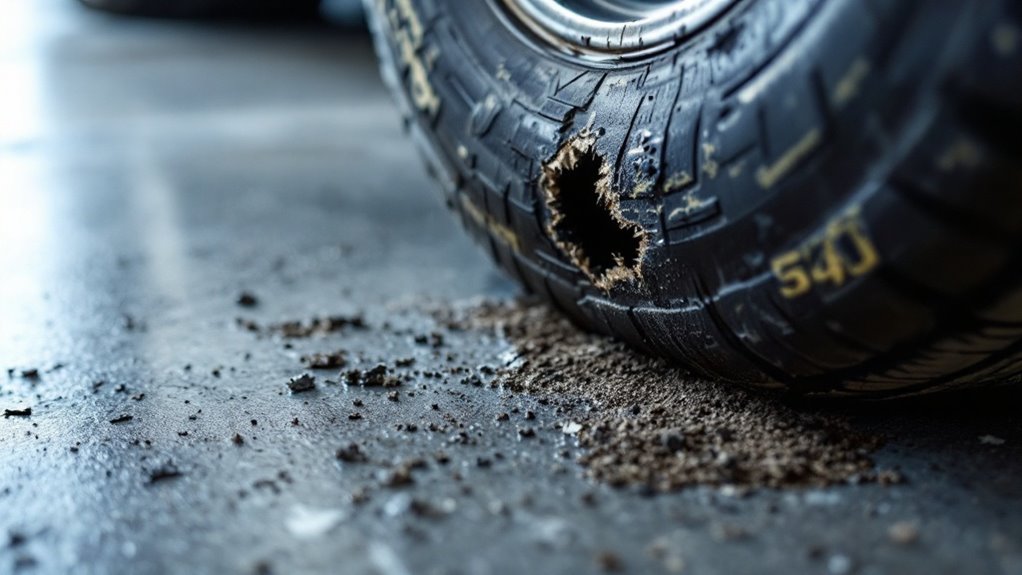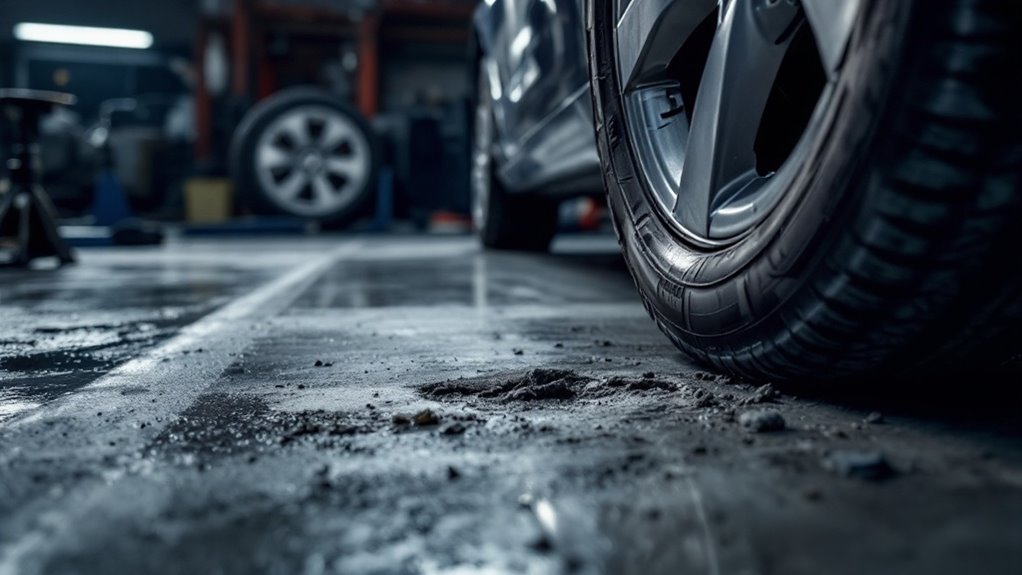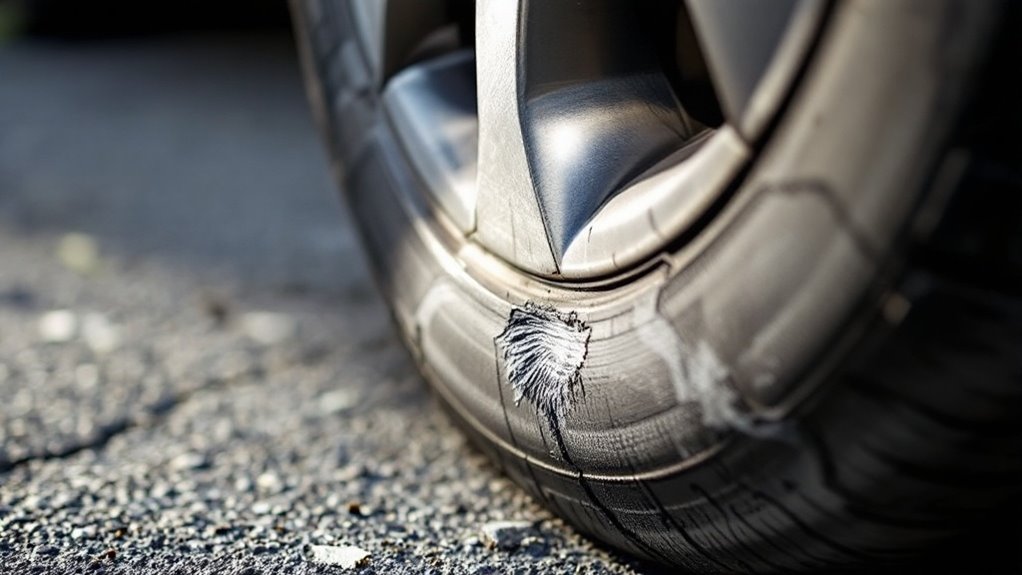Can A Tire Be Patched On The Side
This post contains affiliate links. As an Amazon Associate, we earn from qualifying purchases.
Patching a tire on the sidewall is not recommended due to significant safety risks, as it is strictly advised against by manufacturers and industry standards like those from the USTMA. Sidewall damage can lead to dangerous blowouts, and repairs in this area are often unreliable. For a deeper understanding of the reasons and to explore safe alternatives, further details will be provided later in the article.
Essential Facts in 30 Seconds
- Sidewall tire damage cannot be safely patched due to structural risks.
- Manufacturers and industry standards advise against repairing sidewalls for safety reasons.
- Patching is only suitable for small punctures in the crown area of the tire.
- Sidewall damage typically requires immediate tire replacement to avoid blowouts.
- A professional should assess any suspected sidewall damage.
Understanding Sidewall Damage Risks
Tires face many dangers on the road every day. Sidewalls, the sides of your tires, are super important. They keep your tires strong and safe. But potholes, sharp rocks, or curbs can cut them. These cuts can turn into big problems fast. Low air in tires or too much weight adds stress. This stress can make sidewalls bulge or even burst. A blowout at high speed? That’s scary and dangerous!
Stay safe by checking your tires often. Look closely for cracks or deep scratches. See any bubbles on the sidewall? Don’t ignore them. Some damage hides inside, so ask a pro to check. Regular maintenance can prevent sudden blowout risks. Remember, sidewall repairs are not recommended due to safety risks.
Take these easy steps to protect your tires. Keep the right air pressure in them. Don’t put too much weight in your car. Drive slowly near potholes or rough spots. These small actions save big trouble later!
Why Patching Sidewalls Is Unsafe

Sidewalls of tires face huge stress every day. They bend and flex under heavy loads. A damaged sidewall can fail and cause dangerous blowouts.
Patches on sidewalls often don’t stick well. The material mightn’t match, leading to weak spots. This raises the risk of sudden tire bursts. High speeds on highways make it even worse. Even minor sidewall damage can compromise tire structural integrity and lead to catastrophic failure.
Tire makers warn against fixing sidewalls. Their tests show big safety risks. A failed tire can lead to bad accidents. Always replace a tire with sidewall damage. Don’t take chances with quick fixes. Safety comes first on the road. Consulting with professionals is crucial for assessing sidewall damage and ensuring vehicle safety remains uncompromised.
Sidewall Stress and Risks
Think twice before patching a tire sidewall to save money.
Sidewalls hold huge pressure and flex a lot while driving. Damage like cuts or cracks can mess up stability. A weak sidewall risks dangerous blowouts or tread issues.
Pay close attention to sidewall care for safety. Ignoring it cuts tire life short. It also raises accident chances big time. According to industry standards, sidewall punctures are not repairable due to safety concerns.
Experts say never patch near sidewalls due to stress. Spot bubbling or holes? Act fast! Waiting makes risks grow.
Check tires every month to catch problems early. Simple inspections keep your drives safe. Sidewall damage often requires immediate replacement requires immediate replacement.
Stay alert and protect yourself on the road. Your safety matters most!
Patch Integrity Concerns
Think about patching a tire sidewall. It’s risky! The sidewall faces huge pressure every day. It’s not made for repairs like the tread is. A patch mightn’t hold up. Even a tiny cut can cause big trouble. Driving with a patch could lead to a blowout.
Sidewalls are thin and flexible. They can’t handle patches well. A small hole might look easy to fix. But stress from the road can break it. Let’s look at the dangers.
- Blowout Risk: Patches on sidewalls often fail.
- Weak Spot: Damage stays forever.
Replace the tire instead. It’s the safe choice. You’ll drive with no worries. Safety comes first! Additionally, sidewall damage compromises structural integrity and increases the risk of sudden failure.
Manufacturer Safety Warnings
Tire sidewall patching is dangerous. Manufacturers warn against it for good reasons. Sidewalls face huge stress and flexing. A patch won’t hold up under pressure. This can cause blowouts or tread splitting. You might lose control of your car. Additionally, sidewall damage is widely recognized as irreparable by experts due to the critical role this area plays in tire integrity.
Check this simple table to see the risks:
| Tire Area | Damage Impact | Safety Risk |
|---|---|---|
| Sidewall | Structure gets weak | Blowout can happen |
| Tread Center | Small damage is fixable | Less risk with a patch |
| Near Sidewall | Too risky to repair | Tread may split apart |
Think about your safety first. A damaged tire is a big hazard. Replace it right away. Don’t take chances with patches. Your life matters more than saving money. Stick to safe choices always.
Suitable Areas for Tire Patching

Got a damaged tire? Let’s talk about safe patching spots. Not every area works for repairs. Strict rules show where fixes are okay.
Stick to the crown area. That’s the flat tread touching the road. It’s the best spot for patching. This part stays strong and holds patches well. Make sure punctures are tiny—under 1/4 inch. Keep them 1/2 inch from the tread edge too.
Here’s what you need to know:
- Crown Area Matters: Fix only the tread’s center. Skip shoulders and sidewalls.
- Safe Zone: Punctures must stay in the tread zone.
- Small Holes Only: Damage under 1/4 inch is okay to patch.
- Check the Spot: Avoid flexing areas like sidewalls or shoulders.
Always consult a professional for a proper damage assessment to ensure the tire’s safety after patching.
Guidelines for Safe Tire Repairs

Tire damage needs careful handling for safety and strength. Follow strict rules to fix tires right. First, take the tire off the rim with proper tools. Check the puncture closely for hidden cracks. Look for splits near the damaged spot. Make sure the hole is in the tread area. It must be smaller than ¼ inch. Keep it at least ½ inch from the edge. Location matters a lot for safe repairs.
Now, let’s talk about fixing the tire. Use a carbide cutter to clean the hole. Scrub the inner liner with a good cleaner. Put in a rubber plug and patch together. This creates a strong seal. Stick to USTMA rules for best results. Avoid overlapping with other damage.
Wear safety gear every time. Use a cage while inflating the tire. These steps keep tires safe and strong. Drive with confidence on the road! Remember, sidewall punctures are generally unsafe to repair.
Alternatives to Patching Sidewall Damage

Sidewall damage on a tire can be dangerous. It weakens the tire’s strength. Don’t try risky patches for this problem. Let’s look at safe options instead. These ideas keep you secure on the road.
Check out these four easy ways to fix sidewall damage:
- GlueTread Fix: Use this quick outside repair. It has special glue and spray. You fix the damage fast without taking off the tire.
- Rubber Patch: Grab a strong rubber patch for emergencies. It sticks well but works only short-term.
- Spare Tire Swap: Put on your spare tire right away. This keeps you safe until a better fix.
- Expert Help: Talk to a mechanic for advice. They check the damage and suggest the best step.
Stick to these for safety. Don’t gamble with bad repairs. Your road trip matters! Remember, sidewall punctures are not safely repairable and should always be addressed with caution.
Benefits and Limitations of Tire Patching

Tire patching can fix some damages, but know its good and bad sides first. It saves money by making tires last longer. You avoid buying new tires for small holes under ¼ inch. A good patch can stay strong for 7 to 10 years. That’s a long time with proper care!
Still, not all damages work with patching. Sidewall holes are a big no. Only small tread punctures can get fixed safely. Check this simple table for clarity:
| Topic | Info |
|---|---|
| Patching Good Points | Saves cash, lasts 7-10 years, keeps tires alive |
| Patching Limits | No sidewall fixes, only small tread holes |
| Safety Tip | Needs a pro to do it right |
Always read the tire maker’s rules before you decide. Bad patching might cause big trouble on the road. Remember, professional assessment ensures proper tire safety before hitting the road again.
Frequently Asked Questions
How Long Does a Sidewall Patch Last?
Curious about a sidewall patch? Don’t expect it to hold up well. Sidewall patches often fail fast. Safety risks are high with them. Data shows over 80% of patches on sidewalls break. Trust me, it’s not worth the chance. Go for a new tire instead. That’s the smart and safe pick for you.
Can Sidewall Patches Be Used Temporarily?
Sidewall patches work as a short-term fix for tire damage. Think of them as a quick bandage. They help for now, but danger hides underneath. Safety risks grow if you wait too long. Experts say sidewall patches fail 70% of the time. Don’t trust them for long drives. Replace that tire fast to stay safe. Act now—don’t risk a blowout on the road.
Are There DIY Sidewall Patching Kits?
Got a tire sidewall issue? No worries! DIY sidewall patching kits exist. Find them easily online or at places like Walmart. They come with simple instructions. Learn to fix tires yourself. Save money and time. Many kits cost under $20. Perfect for small damages. Try it out today!
What Tools Are Needed for Sidewall Patching?
Got sidewall damage to fix? You need the right tools for a strong patch. Grab some sandpaper to smooth the area. Use buffing wheels for better prep. Tire spreaders help open the spot. Applicators make the patch stick well. Don’t miss any tool! A good repair lasts longer with these. Trust me, it works every time!
Does Sidewall Patching Affect Tire Warranty?
Got a sidewall patch on your tire? Think twice! Many warranties don’t cover patched sidewalls. Patching often breaks the rules. You might lose all coverage. Stay safe and check the guidelines. Don’t roll with risks. Protect your investment now!
Conclusion
Think about safety first before fixing a tire. Sidewall patches are not safe at all. Sidewalls face huge stress while driving. A weak spot can cause a blowout. Always replace a damaged sidewall tire. Don’t take risks on the road. Only the tread part can get a patch. That too, for tiny holes under ¼ inch. Data shows sidewall repairs fail often. Protect your car and yourself. Make the smart choice today. Stick to safe repair rules. Your journey matters a lot.
